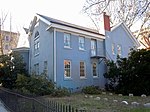International Academy of Trenton
2014 establishments in New Jersey2018 disestablishments in New JerseyCharter schools in New JerseyEducational institutions disestablished in 2018Educational institutions established in 2014 ... and 2 more
Schools in New JerseyTrenton, New Jersey
The International Academy of Trenton (IAT) was a SABIS charter school in the city of Trenton, New Jersey. It was the only school in the now defunct International Academy of Trenton School District, which was a separate governing body from Trenton Public Schools. The school was planned to become a kindergarten through 12th grade school. On January 12, 2018, parents received a letter stating that the New Jersey Department of Education had decided to not renew IAT's charter, citing poor academic performance, causing a closure by the end of the current school year. IAT officially closed on June 30, 2018, the last day of school for students being June 27.
Excerpt from the Wikipedia article International Academy of Trenton (License: CC BY-SA 3.0, Authors).International Academy of Trenton
Perry Street, Trenton
Geographical coordinates (GPS) Address Nearby Places Show on map
Geographical coordinates (GPS)
| Latitude | Longitude |
|---|---|
| N 40.224996 ° | E -74.760155 ° |
Address
Perry Street
08618 Trenton
New Jersey, United States
Open on Google Maps




